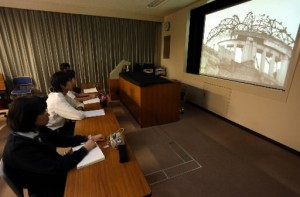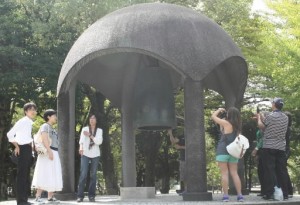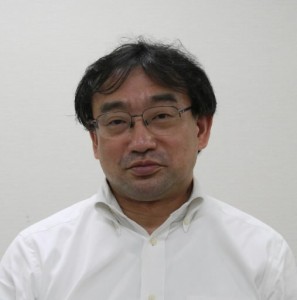Peace Seeds: Hiroshima Teens Report on Peace Issues, Part 10
Oct. 13, 2014
A-bomb Movies: Images that Hold the Power to Move Hearts and Minds
Many movies have been made about the atomic bombing of Hiroshima. Children of Hiroshima, directed by Kaneto Shindo, was filmed with the support of local volunteers in Hiroshima, where the scars of the bombing lingered. My Summertime Map was filmed in today’s Hiroshima by Kenta Fukasaku, a young director of a different generation who was unfamiliar with this history. Showing imagery which reminds us of the A-bomb attack, these movies have powerfully conveyed the spirit of Hiroshima to a wide audience.
Heartbreaking to see lives upturned in Children of Hiroshima
by Kohei Hayashi and Harumi Okada, first-year high school students
We watched Children of Hiroshima at the Hiroshima City Cinematographic and Audio-Visual Library in Naka Ward. In fact, this was the first A-bomb movie shot in Hiroshima.
The setting of the movie is Hiroshima, seven years after the atomic bombing. The shooting was actually done in the city, in the midst of its reconstruction. Seeing the ruins and debris that still remained, we understood the terrible devastation brought about by the atomic bombing.
In this movie, a woman who was once a kindergarten teacher visits the children who used to be her students. The children who survived the atomic bombing are trying to endure each day while suffering from many hardships and facing sad events. A-bomb orphans also appear in the film. It was heartbreaking to see that the bombing deprived people of their normal lives and continued to afflict them.
In the last scene, the sound of an airplane engine is heard in the blue sky and the people remember the B29 bomber that dropped the atomic bomb. Even after the war ended, such memories could not be forgotten.
Watching this movie, we were able to learn more concretely about the horror of the atomic bombing. We are the same age as the children of Hiroshima in the film, and we believe we have a duty to tell the world about the tragedy of the atomic bombing.
“I came to understand the power of Hiroshima by being involved in filmmaking,” says Tomoko Nishizaki of the Hiroshima Film Commission
by Sayaka Kawata, first-year high school student
The junior writers interviewed Tomoko Nishizaki, 48, of the Hiroshima Film Commission, which supports the production of movies and television programs featuring Hiroshima. They asked her about the films she has been involved in, such as The Face of Jizo (directed by Kazuo Kuroki, 2004), Yunagi City, Sakura Country (by Kiyoshi Sasabe, 2007), and My Summertime Map (by Kenta Fukasaku, 2013).
When the director and crew of Yunagi City, Sakura Country were in Hiroshima to shoot the movie, they watched students on school trips singing in front of the Children’s Peace Monument, and grew tearful. One young actor, still a carefree boy, visited Peace Memorial Park every day when the movie was being filmed. Ms. Nishizaki said that the expression on his face gradually changed.
Ms. Nishizaki said, “When people who don’t know anything about the atomic bombing come to Hiroshima, they feel moved. They feel that they have to tell others about it. Hiroshima has that power.” She told us that many more A-bomb films are now being made, including Japanese projects and international productions that will be shown only on TV and online.
She added, “More recent A-bomb films carry the message of the filmmakers who are hoping to take up the efforts of the aging A-bomb survivors, rather than simply replicating the terrible conditions of the aftermath of the atomic bombing. Filmmaking is very important in order to convey what happened in Hiroshima to future generations.”
Interview with Takeshi Sato, supervisor at the Hiroshima City Cinematographic and Audio-Visual Library
As times change, the films change, too
Story by Kantaro Matsuo, first-year high school student, and photo by Shiho Fujii, first-year junior high school student
We interviewed Takeshi Sato, 54, supervisor at the Hiroshima City Cinematographic and Audio-Visual Library in Naka Ward, and asked him about the history of A-bomb films and the changes in their style as time has passed.
The first full-length movie about the atomic bombing was Children of Hiroshima (1952), directed by Kaneto Shindo. Until that time, the occupation forces had banned the making of films about the bombing. Along with Hiroshima (directed by Hideo Sekikawa, 1953), Children of Hiroshima focused on the devastation caused by the atomic bombing as its main theme. Both movies were made with the cooperation of local citizens. Children of Hiroshima was met by a large response from overseas as well.
From the 1960s, movies featuring the suffering caused by A-bomb diseases were produced, relating the love stories of men and women, such as Jun’ai Monogatari [A Story of Pure Love] (directed by Tadashi Imai, 1957) and Ai to Shi no Kiroku [Record of Love and Death] (by Koreyoshi Kurahara, 1966).
Recent films, including Yunagi City, Sakura Country (directed by Sasabe, 2007) and My Summertime Map (directed by Fukasaku, 2013), focus on young people to appeal for the importance of conveying what happened in Hiroshima to younger generations.
About 40 to 50 A-bomb films have been released and shown in theaters, and they have changed with the times.
Junior Writers’ Comments
Sayaka Kawata, first-year high school student
I was surprised to learn that many people in the film industry and the media visit Hiroshima to shoot A-bomb-related films. Tomoko Nishizaki told us, “Hiroshima has power.” I think that if many more people would make movies about Hiroshima and send out their messages to the world, it would fill the gap in people’s awareness toward peace.
Shiho Fujii, first-year junior high school student
Recently, I haven’t been able to take part so often in the junior writers’ activities. Because the interview with Takeshi Sato was my first activity in a long while, I was really nervous. I remembered how I felt when I became a junior writer. I feel refreshed now, and I’d like to have more new experiences.
Harumi Okada, first-year high school student
I didn’t see an A-bomb film for many years. I’m sure many people don’t. When I saw the movie, it was very moving. I understood that the images of these movies remain deep in people’s hearts. I hope there will be more opportunities for people to see these movies so they will remember the tragedy of the atomic bombing.
Aoi Nakagawa, second-year junior high school student
This was the first time I saw an A-bomb movie. I felt so sad watching Children of Hiroshima, which shows the devastation in Hiroshima after the atomic bombing. I hope excellent A-bomb movies will continue to be made so the atomic bombing will be remembered by future generations.
Kantaro Matsuo, first-year high school student
By watching these movies, I was able to understand how A-bomb films have changed with the times. I would like to go deeper when I interview the filmmakers next time and ask them what they really wanted to convey by making these films.
(Originally published on October 13, 2014)










